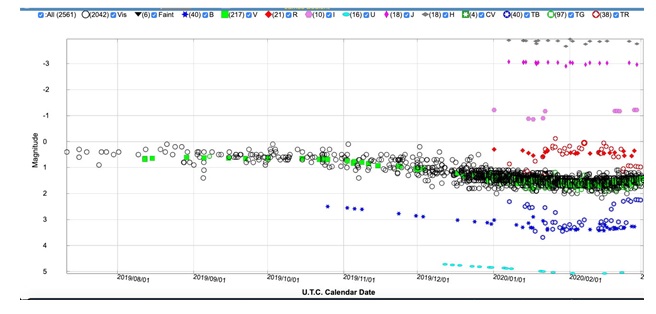
Betelgeuse is classified as a Semi-Regular variable with a period of about 423 days and brightness range from visual mag 0 to mag 1.6. Like all Semi-Regulars the period and both maximum and minimum brightness levels are subject to fluctuations cycle to cycle. This cycle the star dimmed more than a magnitude greater than usual.
This led to speculation that Betelgeuse might be about to explode as a Supernovae. As the surface brightness of highly evolved stars does not reflect the conditions in the core of the star but rather in the energy-producing shells in between I was skeptical of this interpretation.
In looking at the past history of the star I noticed that for about three cycles around 1985 Betelgeuse appears to have had a similar dimming episode. In those cases, the dimming was much less than what we have seen in the last several months but the behavior was similar. Looking back even further toward 1940 there was another similar episode. In that one, however, the star’s maximum brightness stayed below normal for several cycles. The data gets sparse before 1920 so I stopped there.
My hypothesis based on this data was that if Betelgeuse repeated its past history the brightness should bottom out by mid-February and by the end of the month we should have evidence of it brightening. In early February I attended a presentation put on by Los Cumbres Observatory at their “Astronomy on Tap” event. My thinking on the predicted behavior of this star was validated by the UCSB Astronomers making the presentations.
As of Mar 1 the evidence is clear – Betelgeuse stopped dimming and began brightening as predicted. Here is an image of Orion with Betelgeuse top left and another of the latest Light curve of Betelgeuse over this cycle. For our purposes disregard the colored dots- these are measurements taken in the standard Astronomical UBVRI color indexing system. Look at the black dots which are measurements using the Mark I eyeball. They clearly show the dimming, bottoming out and the rise in brightness.
So what will happen when the star does explode? Look to LIGA gravity waves. The collapse of the core should produce a gravity burst which will be seen a full day before the break-out shock reaches the surface of the star.
by CCAS Member Dave Majors
Follow Us: